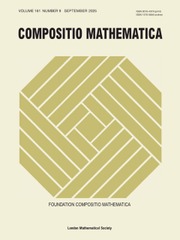No CrossRef data available.
Article contents
Bernstein–Sato polynomials of locally quasi-homogeneous divisors in  $\mathbb{C}^{3}$
$\mathbb{C}^{3}$
Published online by Cambridge University Press: 20 August 2025
Abstract
We consider the Bernstein–Sato polynomial of a locally quasi-homogeneous polynomial  $f \in R = \mathbb{C}[x_{1}, x_{2}, x_{3}]$. We construct, in the analytic category, a complex of
$f \in R = \mathbb{C}[x_{1}, x_{2}, x_{3}]$. We construct, in the analytic category, a complex of  $\mathscr{D}_{X}[s]$-modules that can be used to compute the
$\mathscr{D}_{X}[s]$-modules that can be used to compute the  $\mathscr{D}_{X}[s]$-dual of
$\mathscr{D}_{X}[s]$-dual of  $\mathscr{D}_{X}[s] f^{s-1}$ as the middle term of a short exact sequence where the outer terms are well understood. This extends a result by Narváez Macarro where a freeness assumption was required. We derive many results about the zeros of the Bernstein–Sato polynomial. First, we prove each nonvanishing degree of the zeroth local cohomology of the Milnor algebra
$\mathscr{D}_{X}[s] f^{s-1}$ as the middle term of a short exact sequence where the outer terms are well understood. This extends a result by Narváez Macarro where a freeness assumption was required. We derive many results about the zeros of the Bernstein–Sato polynomial. First, we prove each nonvanishing degree of the zeroth local cohomology of the Milnor algebra  $H_{\mathfrak{m}}^{0} (R / (\partial f))$ contributes a root to the Bernstein–Sato polynomial, generalizing a result of M. Saito (where the argument cannot weaken homogeneity to quasi-homogeneity). Second, we prove the zeros of the Bernstein–Sato polynomial admit a partial symmetry about
$H_{\mathfrak{m}}^{0} (R / (\partial f))$ contributes a root to the Bernstein–Sato polynomial, generalizing a result of M. Saito (where the argument cannot weaken homogeneity to quasi-homogeneity). Second, we prove the zeros of the Bernstein–Sato polynomial admit a partial symmetry about  $-1$, extending a result of Narváez Macarro that again required freeness. We give applications to very small roots, the twisted logarithmic comparison theorem, and more precise statements when f is additionally assumed to be homogeneous. Finally, when f defines a hyperplane arrangement in
$-1$, extending a result of Narváez Macarro that again required freeness. We give applications to very small roots, the twisted logarithmic comparison theorem, and more precise statements when f is additionally assumed to be homogeneous. Finally, when f defines a hyperplane arrangement in  $\mathbb{C}^{3}$ we give a complete formula for the zeros of the Bernstein–Sato polynomial of f. We show all zeros except the candidate root
$\mathbb{C}^{3}$ we give a complete formula for the zeros of the Bernstein–Sato polynomial of f. We show all zeros except the candidate root  $-2 + (2 / \deg(f))$ are (easily) combinatorially given; we give many equivalent characterizations of when the only noncombinatorial candidate root
$-2 + (2 / \deg(f))$ are (easily) combinatorially given; we give many equivalent characterizations of when the only noncombinatorial candidate root  $-2 + (2/ \deg(f))$ is in fact a zero of the Bernstein–Sato polynomial. One equivalent condition is the nonvanishing of
$-2 + (2/ \deg(f))$ is in fact a zero of the Bernstein–Sato polynomial. One equivalent condition is the nonvanishing of  $H_{\mathfrak{m}}^{0}( R / (\partial f))_{\deg(f) - 1}$.
$H_{\mathfrak{m}}^{0}( R / (\partial f))_{\deg(f) - 1}$.
Keywords
MSC classification
Information
- Type
- Research Article
- Information
- Copyright
- © The Author(s), 2025. The publishing rights in this article are licensed to Foundation Compositio Mathematica under an exclusive licence
Footnotes
Dedicated to Brandy Ambrose-Bath, beloved in perpetuity.


